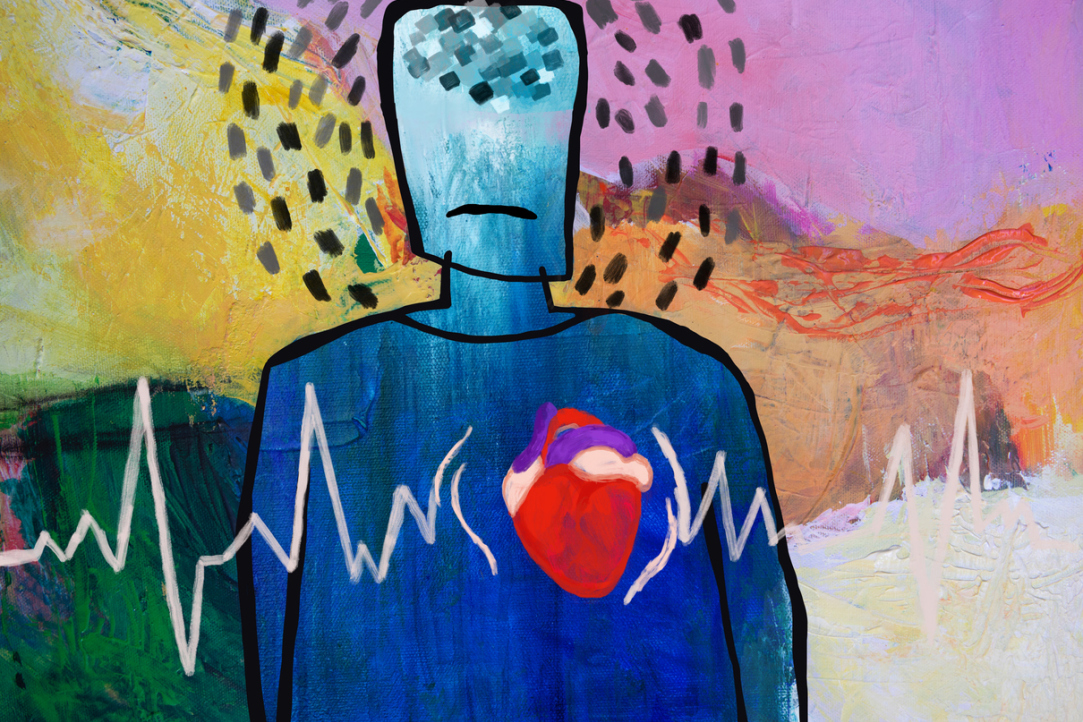HSE Scientists Propose Using Heart Rate Analysis to Diagnose Anxiety and Depression

A group of scientists at HSE University have discovered how anxiety and depression can be diagnosed by analysing heart rate. It turns out that under mental stress, the heart rate of individuals with a predisposition to mental health disorders differs from that of healthy individuals, especially when performing more complex tasks. These changes in cardiovascular parameters can even be detected using a pulse oximeter or a smartwatch. The study findings have been published in Frontiers in Psychiatry.
According to the World Health Organization, one in five adults under the age of 30 suffers from depression or an anxiety disorder. To prevent the development of mental health conditions and treat them effectively, reliable personalised diagnostic methods are needed.
Today, many technology companies are developing mental health analysis systems based on heart rate data. Various wearable devices, such as smartwatches, bracelets, rings, and others, are used for this purpose. However, it is important not only to record changes in heart rate but also to interpret them accurately.
Scientists at HSE University, in collaboration with the Russian Academy of Sciences Institute of Higher Nervous Activity and Neurophysiology, conducted a study to determine whether signs of depression and anxiety can be detected through changes in heart rate during cognitive tasks. They performed an experiment with 90 subjects, aged 18 to 45, some of whom had a history of anxiety and depression episodes.
Participants completed memory and attention tasks that gradually increased in complexity: they were instructed to view images of coloured balls and compare each one with the previous one to identify colour matches. As the difficulty level increased, participants had to memorise more balls and colours.
During the experiment, participants' heart rates were recorded using an electrocardiogram (ECG), while simultaneously photoplethysmography (PPG) was conducted to analyse heart function based on changes in blood volume in peripheral vessels. This simple, non-invasive method allows data to be read from the finger or wrist; PPG is the technology used in all wearable devices today.

Data analysis revealed that individuals with higher levels of anxiety or depression exhibited more pronounced changes in heart rate, particularly during complex tasks.
'When faced with a challenging task, people experience stress. They can make mistakes, which is normal and does not necessarily indicate a mental health issue. However, at a critical point of increasing complexity—when the task is still manageable but requires maximum attention—individuals with signs of mental disorders exhibit a higher average heart rate, resulting in a more pronounced and distinct pattern of heart rate variability,' explains Evgeniia Alshanskaia, Junior Research Fellow at the Institute for Cognitive Neuroscience.
A key aspect of the experiment was the comparison of data obtained using EEG and PPG. Although EEG is traditionally regarded as a more reliable method for measuring heart rate variability, the study indicated that PPG might be a more sensitive tool for assessing depression and anxiety. The scientists attribute this to the specific characteristics of the sympathetic nervous system.
'Under stress, noradrenaline, which is linked to attention, is activated first, followed by the activation of adrenaline, which prepares the body for action and triggers the "fight or flight" response. Our heart rate increases, and our blood pressure rises. Noradrenaline also acts on receptors that induce vasoconstriction. At this stage, changes in the pulse wave can be observed using PPG. Only afterward is adrenaline released from the adrenal glands, which amplifies and prolongs the body's stress response, causing the heart to beat faster. Subsequently, changes are observed on the ECG. This indicates that PPG is a relatively reliable method that is also more accessible, faster, and informative compared to ECG,' according to Alshanskaia.
The study demonstrates that changes in heart rate in response to increasing cognitive load can serve as an early biomarker for anxiety and depressive disorders. Additionally, the findings from the experiment open new opportunities for developing algorithms for wearable devices and applications that can monitor a person’s psychological state in real time. Early, personalised, and non-invasive diagnosis of depressive and anxiety disorders through heart rate analysis could significantly transform the approaches to treatment and prevention of mental health conditions in the future.
The study was conducted within the framework of the Strategic Project 'Success and Self-Sustainability of the Individual in a Changing World' (Priority 2030 programme).
See also:
Scientists Present New Solution to Imbalanced Learning Problem
Specialists at the HSE Faculty of Computer Science and Sber AI Lab have developed a geometric oversampling technique known as Simplicial SMOTE. Tests on various datasets have shown that it significantly improves classification performance. This technique is particularly valuable in scenarios where rare cases are crucial, such as fraud detection or the diagnosis of rare diseases. The study's results are available on ArXiv.org, an open-access archive, and will be presented at the International Conference on Knowledge Discovery and Data Mining (KDD) in summer 2025 in Toronto, Canada.
Hi-Tech Grief: HSE Researchers Explore the Pros and Cons of Digital Commemoration
Researchers at HSE University in Nizhny Novgorod have explored how technological advancements are transforming the ways in which people preserve the memory of the deceased and significant events. Digital technologies enable the creation of virtual memorials, the preservation of personal stories and belongings of the deceased, interaction with their digital footprint, and even the development of interactive avatars based on their online activity. However, these technologies not only evoke nostalgia and provide a sense of relief but can also heighten anxiety and fear, and delay the process of accepting loss. The study has been published in Chelovek (The Human Being).
Scientists Find Out Why Aphasia Patients Lose the Ability to Talk about the Past and Future
An international team of researchers, including scientists from the HSE Centre for Language and Brain, has identified the causes of impairments in expressing grammatical tense in people with aphasia. They discovered that individuals with speech disorders struggle with both forming the concept of time and selecting the correct verb tense. However, which of these processes proves more challenging depends on the speaker's language. The findings have been published in the journal Aphasiology.
Implementation of Principles of Sustainable Development Attracts More Investments
Economists from HSE and RUDN University have analysed issues related to corporate digital transformation processes. The introduction of digital solutions into corporate operations reduces the number of patents in the field of green technologies by 4% and creates additional financial difficulties. However, if a company focuses on sustainable development and increases its rating in environmental, social, and governance performance (ESG), the negative effects decrease. Moreover, when the ESG rating is high, digitalisation can even increase the number of patents by 2%. The article was published in Sustainability.
Russian Scientists Develop New Compound for Treating Aggressive Tumours
A team of Russian researchers has synthesised a novel compound for boron neutron capture therapy (BNCT), a treatment for advanced cancer that uses the boron-10 isotope. The compound exhibits low toxicity, excellent water solubility, and eliminates the need for administering large volumes. Most importantly, the active substance reaches the tumour with minimal impact on healthy tissues. The study was published in the International Journal of Molecular Sciences shortly before World Cancer Day, observed annually on February 4.
Scientists Discover Link Between Brain's Structural Features and Autistic Traits in Children
Scientists have discovered significant structural differences in the brain's pathways, tracts, and thalamus between children with autism and their neurotypical peers, despite finding no functional differences. The most significant alterations were found in the pathways connecting the thalamus—the brain's sensory information processing centre—to the temporal lobe. Moreover, the severity of these alterations positively correlated with the intensity of the child's autistic traits. The study findings have been published in Behavioural Brain Research.
Earnings Inequality Declining in Russia
Earnings inequality in Russia has nearly halved over the past 25 years. The primary factors driving this trend are rising minimum wages, regional economic convergence, and shifts in the returns on education. Since 2019, a new phase of this process has been observed, with inequality continuing to decline but driven by entirely different mechanisms. These are the findings made by Anna Lukyanova, Assistant Professor at the HSE Faculty of Economic Sciences, in her new study. The results have been published in the Journal of the New Economic Association.
Russian Physicists Discover Method to Increase Number of Atoms in Quantum Sensors
Physicists from the Institute of Spectroscopy of the Russian Academy of Sciences and HSE University have successfully trapped rubidium-87 atoms for over four seconds. Their method can help improve the accuracy of quantum sensors, where both the number of trapped atoms and the trapping time are crucial. Such quantum systems are used to study dark matter, refine navigation systems, and aid in mineral exploration. The study findings have been published in the Journal of Experimental and Theoretical Physics Letters.
HSE Scientists Develop Application for Diagnosing Aphasia
Specialists at the HSE Centre for Language and Brain have developed an application for diagnosing language disorders (aphasia), which can result from head injuries, strokes, or other neurological conditions. AutoRAT is the first standardised digital tool in Russia for assessing the presence and severity of language disorders. The application is available on RuStore and can be used on mobile and tablet devices running the Android operating system.
HSE Researchers Discover Simple and Reliable Way to Understand How People Perceive Taste
A team of scientists from the HSE Centre for Cognition & Decision Making has studied how food flavours affect brain activity, facial muscles, and emotions. Using near-infrared spectroscopy (fNIRS), they demonstrated that pleasant food activates brain areas associated with positive emotions, while neutral food stimulates regions linked to negative emotions and avoidance. This approach offers a simpler way to predict the market success of products and study eating disorders. The study was published in the journal Food Quality and Preference.



